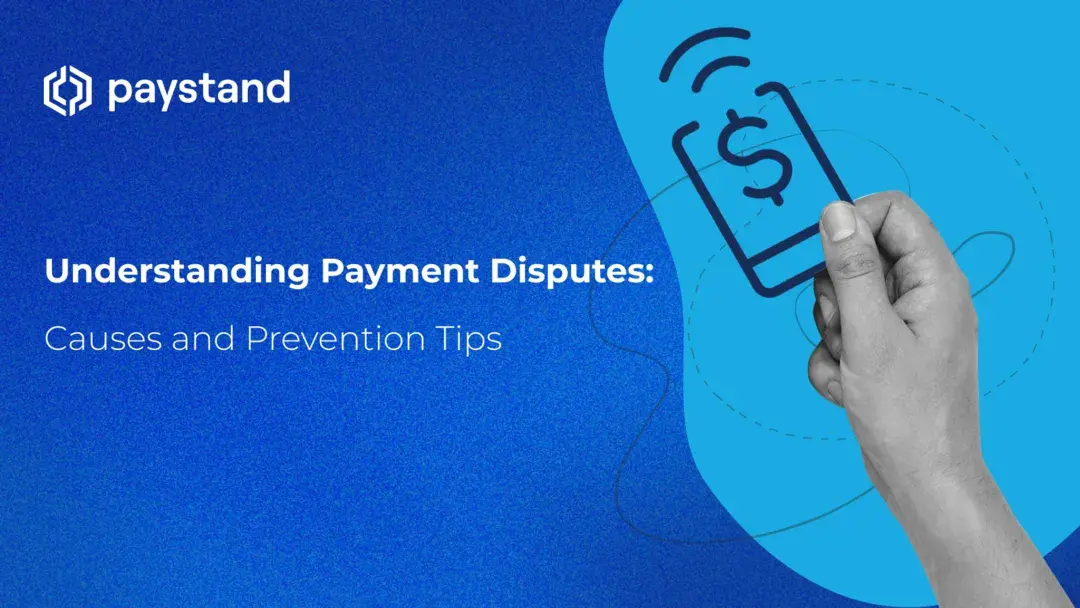Understanding Payment Disputes: Causes and Prevention Tips

Table of Contents
- What does payment dispute mean?
- How do I resolve a payment dispute?
- What does the payment dispute process look like?
- How can businesses prevent payment disputes?
- Eliminate payment headaches with Paystand
Key Takeaways
- A payment dispute occurs when a cardholder requests a refund from their issuing bank for a purchase they made, often due to fraud or dissatisfaction.
- Disputes can occur for various reasons, including fraudulent payments, undelivered or misrepresented products, unrecognized charges, and administrative errors like duplicate billing.
- Resolving a payment dispute involves the issuing bank investigating the claim by contacting the merchant, who can provide evidence to defend their case.
- If the business fails to provide sufficient evidence, the bank issues a chargeback, deducting the disputed amount from the merchant and applying chargeback fees.
Navigating the complexities of digital payments, like payment disputes, can significantly impact a business's cash velocity and overall financial health. Along with chargebacks and associated fees, they can drain resources and slow down essential processes. But what if there were a way to streamline payments and protect the bottom line? In this article, we’ll explore the ins and outs of payment disputes and offer practical steps to prevent them.
Want to eliminate the friction from your payment process? Keep reading to learn how to optimize your digital payments strategy and maintain the speed of cash within your organization.
What Does Payment Dispute Mean?
A payment dispute arises when a cardholder contacts their issuing bank and requests a refund for a purchase they made using their credit or debit card. This dispute process is an essential feature of major card networks such as Visa, Mastercard, and American Express.
Why Do Disputes Occur?
Customers typically file for a dispute when they think a payment is fraudulent. However, sometimes customers file disputes because they don’t recognize the charge, feel that the company did not deliver the product or service promised, or are doing something unethical, such as claiming not to recognize the charge even when they agreed to pay.
Here are a few of the most common reasons for disputes:
- The payment was fraudulent. If the customer claims that they did not authorize the purchase, fraud has occurred: somehow, the customer’s card information was stolen and used without their knowledge and consent.
- The payment was not as described. If customers never receive the products or services they pay for or are delivered differently than they were told, they can file a dispute.
- The customer did not recognize the payment. Customers who do not recognize a charge on their bank statement will likely think it is fraudulent and dispute it.
- An admin error was committed. Admin errors such as duplicate billing, incorrect billing amounts, or never-issued refunds can occur and cause a dispute to be initiated.
How Do I Resolve a Payment Dispute?
When cardholders initiate a payment dispute, they typically contact their issuing bank's customer service department and provide details about the disputed transaction. This information may include the date of the purchase, the amount charged, the merchant's name, and the reason for the dispute. The cardholder may also be required to provide supporting documentation, such as a copy of the receipt or a screenshot of the online purchase.
Once the issuing bank receives the dispute, it investigates the matter by contacting the merchant and requesting additional information. The merchant can provide their version of events and any evidence they have to support their position. The issuing bank thoroughly reviews all available information before deciding on the dispute.
If the issuing bank determines that the cardholder's claim is valid, it will issue a chargeback to the merchant. The disputed amount will be deducted from the merchant's account and credited to the cardholder's account. The merchant may challenge the chargeback by providing additional evidence or disputing the issuing bank's findings.
What Does the Payment Dispute Process Look Like?
If customers find unrecognized or fraudulent charges on their accounts, they will contact their issuing banks (the banks that issued them their credit cards). This is what initiates the dispute process. The card networks usually allow cardholders to initiate disputes within 120 days of the original payment, but this time frame is not always rigid. For example, for industries like travel and ticketing, where the payment is usually made far in advance before the event occurs, the 120-day period to file the dispute will usually happen when the event or travel occurs, not when the payment was made.
Once customers file a dispute, they must show evidence to their issuing bank that they were unaware of the charge or that the charge was fraudulent. Following this, the business associated with the disputed charge will have a limited time—usually seven to twenty-one days, depending on their card network—to respond to the card issuer’s claim. The business will also be required to offer evidence to the issuing bank to prove that the customer intended to pay for the product or service that the charge reflects.
Suppose the business cannot provide enough evidence to support that the customer intended to make the purchase. In that case, a chargeback will occur: the bank will refund the customer’s purchase and then charge the business for the work it takes to complete this process – this is what’s known as the chargeback fee. If the business can prove that the customer intended to make the payment, the business will not lose the funds to the customer; however, the business will still incur the chargeback fee.
Businesses want to avoid chargebacks at all costs – they cost penalties that drain companies' revenue. If companies start to see high volumes of chargebacks, they will have a more challenging time accessing payment processing services at a reasonable rate.
However, it’s important to note that 86% of all chargebacks stem from intentional or unintentional fraud. As a result, merchants need to understand this fact and take preventative measures to prevent disputes and the chargebacks and chargeback fees that accompany them.
How Can Businesses Prevent Payment Disputes?
Businesses that proactively find ways to prevent disputes can avoid chargebacks and their associated fees. Here are a few things you can do to avoid unnecessary loss of funds:
- Use multi-layered payment protocols. Prevent fraud at checkout with a multilayer approach, including alerts, validation tools, address confirmations, buyer velocity limits, email verification, and device fingerprinting.
- Analyze your chargeback data. POS systems and chargeback management platforms help identify customer and employee fraud through data analysis, fraud prevention tools, and real-time reporting.
- Create a transparent shipping and billing process. Provide tracking information to prevent customer disputes. Offer enhanced shipping options and notify customers of delays or out-of-stock items.
- Properly manage customer expectations. Communicate delivery times to customers. Advertise product quality honestly. This way, customers know what they're buying and when they'll receive it, reducing the likelihood of disputes.
- Train your staff on best practices. To prevent chargebacks, train customer-facing employees to recognize suspicious transactions and collect evidence for future disputes. Respond promptly to dissatisfied customers to avoid disputes, and if one arises, respond swiftly to the issuing bank to minimize financial loss.
- Make your return and dispute processes clear and easy. Prevent chargebacks by making it easy for customers to contact you: add a FAQ page, follow up after purchases, automate returns, offer free return shipping, and provide 24/7 customer service.
Eliminate Payment Headaches with Paystand
Paystand is revolutionizing how businesses handle payments by eliminating credit card fees through its B2B network, helping organizations increase their cash velocity. By automating payment workflows and leveraging the power of blockchain, Paystand simplifies ERP payments and helps companies protect themselves against costly disputes and chargebacks.
Ready to transform your payment processes? Download our ebook on Digital Payments in the Supply Chain to learn how Paystand can help you streamline your financial operations. Download now.





